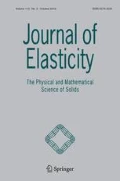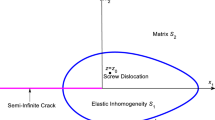Abstract
Employing primarily analytic continuation, we derive analytical solutions to the anti-plane problem associated with a screw dislocation located anywhere inside an anisotropic tri-material composed of an intermediate anisotropic elastic layer of finite thickness sandwiched between two semi-infinite anisotropic elastic media. All three phases of the tri-material are monoclinic with the symmetry plane at \(x_{3}=0\) in a Cartesian coordinate system. We obtain explicit expressions for each one of the three analytic functions defined in its respective anisotropic elastic phase. This allows for the complete determination of the stresses and displacement in the tri-material. In addition, we present simple yet concise expressions for the image force acting on the screw dislocation. An interfacial Zener-Stroh crack in the tri-material is discussed using the analytical solution developed for an interfacial screw dislocation.



Similar content being viewed by others
References
Chou, Y.T.: Screw dislocations in and near lamellar inclusions. Phys. Status Solidi B 17, 509–516 (1966)
Lin, L.S., Chou, Y.T.: Screw dislocations in a three-phase anisotropic medium. Int. J. Eng. Sci. 13, 317–325 (1975)
Ma, C.C., Lu, H.T.: Theoretical analysis of screw dislocations and image forces in anisotropic multilayered media. Phys. Rev. B 73, 144102 (2006)
Suo, Z.G.: Singularities interacting with interfaces and cracks. Int. J. Solids Struct. 25, 1133–1142 (1989)
Suo, Z.G.: Singularities, interfaces and cracks in dissimilar anisotropic media. Proc. R. Soc. Lond. A 427, 331–358 (1990)
Wang, X., Schiavone, P.: New solution for a screw dislocation in a multilayered laminate. Eur. J. Mech. A, Solids 76, 321–327 (2019)
Dundurs, J.: Elastic interaction of dislocations with inhomogeneities. In: Mura, T. (ed.) Mathematical Theory of Dislocations, pp. 70–115. American Society of Mechanical Engineers, New York (1969)
Ting, T.C.T.: Anisotropic Elasticity-Theory and Applications. Oxford University Press, New York (1996)
Erdogan, F., Gupta, G.D.: On the numerical solution of singular integral equations. Q. Appl. Math. 29, 525–534 (1972)
Xiao, Z.M., Fan, H.: A Zener-Stroh crack near an interface. Int. J. Solids Struct. 34, 2829–2842 (1997)
Atkinson, C.: On cracks and screw dislocation pile ups crossing a bimaterial interface. J. Elast. 3, 15–22 (1973)
Zhang, H.T., Chou, Y.T.: Antiplane eigenstrain problem of elliptic inclusion in a two-phase anisotropic medium. J. Appl. Mech. 52, 87–90 (1985)
Ru, C.Q.: Two dimensional Eshelby’s problem for two bonded piezoelectric half-planes. Proc. R. Soc. Lond. A 457, 865–883 (2001)
Yu, H.T.: Two-dimensional elastic defects in orthotropic bicrystals. J. Mech. Phys. Solids 49, 261–287 (2001)
Benveniste, Y.: A general interface model for a three-dimensional curved thin anisotropic interphase between two anisotropic media. J. Mech. Phys. Solids 54, 708–734 (2006)
Dai, M., Schiavone, P.: Analytic solution for a line edge dislocation in a bimaterial system incorporating interface elasticity. J. Elast. 132, 295–306 (2018)
Acknowledgements
This work is supported by a Discovery Grant from the Natural Sciences and Engineering Research Council of Canada (Grant No: RGPIN – 2017 - 03716115112).
Author information
Authors and Affiliations
Corresponding authors
Additional information
Publisher’s Note
Springer Nature remains neutral with regard to jurisdictional claims in published maps and institutional affiliations.
Appendices
Appendix A
Equation (7b) can be rewritten in the following form
In view of Eq. (9), Eq. (A.1) can be rewritten as
By substituting the expressions for \(z_{3}\) and \(\bar{z}_{3}\) in Eq. (13a) into Eq. (A.2), we arrive at Eq. (10).
In addition, Eq. (7a) can be written in the form
By substituting the expression for \(f_{2}(z_{2})\) in Eq. (10) into Eq. (A.3) and making use of the expressions of \(z_{2}\) and \(\bar{z}_{2}\) in Eq. (13b), we finally obtain Eq. (11).
Appendix B
Equation (12) can be written in the form
where
The expression for \(g(z)\) in Eq. (14) is obtained by examining Eq. (B.1) and observing that \(f_{1}(z_{1})\) exhibits the following logarithmic singular behavior at the location of the screw dislocation
but remains regular at all points away from the location of the screw dislocation.
Rights and permissions
About this article
Cite this article
Wang, X., Schiavone, P. A Screw Dislocation in a Monoclinic Tri-Material. J Elast 142, 395–407 (2020). https://doi.org/10.1007/s10659-020-09799-0
Received:
Accepted:
Published:
Issue Date:
DOI: https://doi.org/10.1007/s10659-020-09799-0




